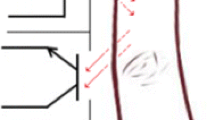Abstract
The cardiokymograph or displacement cardiograph (DCG) is a non-contacting device which senses movement of the heart throughout the cardiac cycle by the interaction of a radiofrequency (10–20 MHz) electromagnetic field, generated by a sensing coil, with the thorax. In the paper three different techniques of detecting this movement will be discussed: monitoring the changes in sensing resonant frequency (FM modulation), monitoring the changes in impedance of the coil at resonant frequency (AM modulation) and a new technique which monitors the changes in coil impedance at fixed frequency. The sensitivities of these three techniques will be compared. A simplified theory of the mode of coupling between the coil and the thorax will be studied in terms of a transformer model. Preliminary clinical measurements of anterior left and right ventricular motion will be given. The presence of higher-frequency features related to atrial motion and the opening and closing of the aortic and pulmonary values will also be described.
Similar content being viewed by others
References
Kwok, M. C. (1988) Detection of cardiac motion via electromagnetic coupling. Ph.D Thesis, University of Kent, Canterbury, UK, May 1988.
Kwok, M. C. andPepper, M. G. (1991) Noninvasive detection of ventricular wall motion by electromagnetic coupling. Part 1 Theory: the changes in the reflected impedance of a coil over a semi-infinite medium with properties ranging from lossy dielectric to a conductor.Med. & Biol. Eng. & Comput.,29, 136–140.
Smythe, W. R. (1968)Static and dynamic electricity, 3rd edn. McGraw-Hill-Book 381.
Vas, R. (1967) Electronic device for physiological kinetic measurement and detection of extraneous bodies.IEEE Trans.,BME-14, 2–6.
Wilson, D. L. (1981) Physical principle of the displacement cardiograph including a new device sensitive to variation in torso resistivity. ——Ibid. -28, 702–710.
Author information
Authors and Affiliations
Rights and permissions
About this article
Cite this article
Pepper, M.G., Taylor, D.J.E. & Kwok, M.C. Noninvasive detection of ventricular wall motion by electromagnetic coupling. Med. Biol. Eng. Comput. 29, 141–148 (1991). https://doi.org/10.1007/BF02447099
Received:
Accepted:
Issue Date:
DOI: https://doi.org/10.1007/BF02447099




